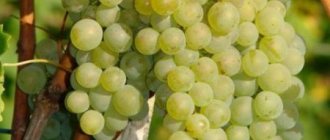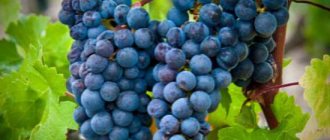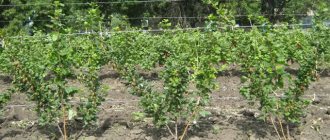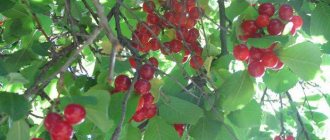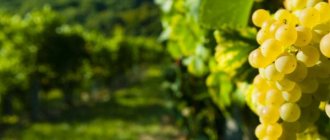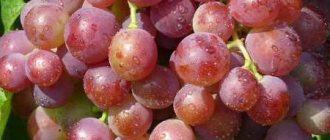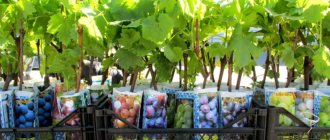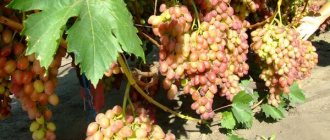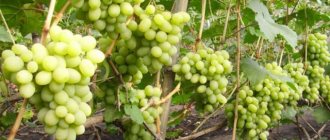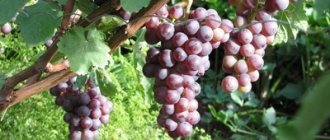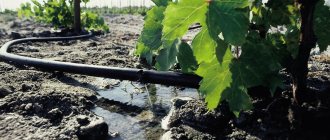Solaris grapes are the result of German selection, crossing the Northern Saperavi and Muscat Ottonel varieties. Characterized by early ripening, intended for winemaking. White wines from Solaris are distinguished by high quality and a pleasant flavor bouquet with fruity and nutty tones. The variety is quite adapted to the Russian temperate climate, therefore it is popular and valued for its reliability and unpretentiousness.
Solaris grapes are the result of German selection
Solaris grapes: variety description, photo
Solaris is an excellent technical wine variety, which is used for making aromatic white wines, as well as for fresh consumption. It is characterized by early ripening: the first harvest is produced at the end of July or early August. The growing season lasts from 105 to 115 days.
It is quite simple to understand that the grapes are fully ripe - shoot growth stops completely, and the berries turn a characteristic amber color. The Solaris grape variety has tall, strong bushes that sprout shoots in the spring. In two years they grow up to five meters in height. This allows you to decorate them with a decorative arch.
Solaris - grapes, a photo of which you can see in the article, is characterized by a fairly high yield - from 3 to 5 kg of fruit per square meter. And this is not the limit. Productivity can easily be increased by using grafting, which is an optional but desirable procedure, as it will make the grapes more productive and frost-resistant, although this variety tolerates harsh Russian winters quite well and can withstand frosts down to -30 °C.
Botanical certificate
Solaris is an early-ripening grape variety; it is characterized by a growing season of 105-115 days. The first harvest can be harvested in late July or early August.
Bushes and shoots
This hybrid variety is characterized by intensive growth rates. The culture is capable of growing up to 5 meters in height in 2 years.
The plant is considered vigorous and spreading. It quickly produces shoots that gain green mass.
The foliage has a traditional shape and standard green color. The branches are medium in size and have a slightly loose structure. They can be easily cut and shaped.
The bush is characterized by rapid growth, therefore it needs systematic formation. The procedure is recommended starting from 3 years of age.
Bunches and berries
The main advantage of the plant is the early period of ripening of the berries. The ripeness of the fruit is indicated by the complete cessation of shoot development and their coloring in amber color. At the same time, the sugar content in ripe berries increases significantly, while the acidity parameters, on the contrary, decrease.
The fruits of this grape variety weigh 4-6 grams. They are characterized by a white or amber color. The fruits form cylindrical clusters. They weigh 300-400 grams. The brushes are characterized by a rather loose structure.
The taste of the fruit is quite pleasant. They have a mild, refreshing taste. It has slight notes of pineapple and pear. The sugar content in fruits is 22-24%. At the same time, the acidity parameters are at the level of 8 grams per liter.
At the end of October, sugar content reaches 30%. The pulp has a dense structure and contains a lot of clear juice.
The fruits of this plant have a number of beneficial properties. Freshly squeezed juice helps prevent blood clots and reduce cholesterol in the blood. The medicinal properties of the plant help with hypertension and nervous diseases. Berries perfectly cleanse the blood.
In addition, the fruits of the plant contain many valuable acids - oxalic, tartaric, malic. These components improve digestive functions, normalize appetite, cleanse the body of toxic elements and have a good effect on the state of microflora.
Pollinators and flowering
The flowers of this grape are bisexual. Therefore, the plant is well pollinated and produces a good harvest even in unfavorable weather conditions. The plant does not have a tendency to pea fruit. Its buds and ovaries do not fall off.
Maturation period
The variety is distinguished by its early ripening period. At normal temperatures of +20-30 degrees, the crop will ripen within 105-115 days. The early growing season begins in the second half of July or early August. At lower temperatures this can also happen at the end of August.
To determine the ripening of grapes, you should pay attention to the following features:
- shoots stop developing;
- the berries turn amber.
Productivity
The hybrid is characterized by high yield parameters. This figure is 3-5 kilograms per 1 square meter. Under favorable weather conditions and strict implementation of agrotechnical recommendations, plant productivity increases significantly. On average, 80-105 centners of fruit can be obtained from 1 hectare of plantings.
Transportability and use of berries
The berries of this variety are characterized by a high juice content. Therefore, they should be transported carefully. It is recommended to place undamaged bunches in plastic or wooden boxes. They are placed in one layer and covered with straw.
At home, it is recommended to store grapes for 3 months in a dry and well-ventilated area. In this case, the temperature indicators should be +4 degrees.
Grapes can be consumed fresh or processed. Juice and other preparations are made from it. Solaris is also actively used for the production of high-quality white wine. It has a fruity bouquet and contains notes of pineapple and hazelnut.
See also
Description of the Nizina grape variety, planting and care in open ground
Read
Fruit
Solaris grapes are literally strewn with numerous cylindrical trusses with medium-sized round berries. The weight of a brush is from 300 to 400 grams, one berry - from 4 to 6 grams. The berries are round in shape and amber in color. In early September, the sugar content is 22%, acidity is more than 8 g/l. In October, sugar content often increases to 30%. This explains the surprisingly delicate and pleasant sweet taste, slightly reminiscent of pineapple.
Beneficial features
Probably everyone knows the beneficial properties of all types of grapes. Solaris is no exception. Regular consumption of juice from the berries of this variety prevents the formation of blood clots, reduces the level of “bad” cholesterol, and prevents the development of atherosclerosis.
The acids contained in the pulp of berries have a beneficial effect on the gastrointestinal tract and help remove toxins from the body. A glass of warm grape juice for a cold softens a cough and soothes an irritated throat. Solaris grapes contain antioxidants that reduce the risk of developing cancer. Eating the dried fruits of this grape (raisins) will help cure nephritis and hepatitis.
Description
Solaris grape juice is widely used for medicinal purposes. Regular intake of juice reduces the level of bad cholesterol, strengthens vascular walls, normalizes blood pressure and heart rate, relieves inflammation in the upper respiratory tract and genitourinary system, and stimulates the digestive system.
Grapes contain antioxidants that neutralize free radicals, thereby protecting cells from cancerous transformations. Folic acid has a beneficial effect on reproductive function. For medicinal purposes, grapes are used both fresh (fruits, leaves) and dried.
Solaris grapes are used in cosmetology. Its juice has anti-aging and regenerating properties, and has a whole range of beneficial effects on the skin. For cosmetic purposes, grapes can be used both fresh and as cosmetics with the addition of juice and oils.
Solaris grapes are resistant to frost; its woody shoots can withstand temperatures down to -30°C, and young vines can withstand temperatures down to -21°C.
It is characterized by high growth rates and a relatively short period of fruit ripening, 105-115 days. In temperate latitudes, the harvest is harvested at the end of July, at the beginning of August. In case of cold summer, fruit ripening will be slower.
Solaris quickly gains vegetative mass and forms a dense, vigorous bush. This quality makes it suitable for grafting. The plant is not picky about soil. However, swampy soils, areas with shallow groundwater and salt marshes are not suitable for its cultivation.
In fresh Solaris grapes, the sugar content is 22%, the acid content is 8 g/l. Like most, they have a round shape and small size (4-6 g), with a high juice content. The juice is clear, and the fruits themselves are white with a yellowish or greenish tint. The berries have an amazing feature: when fermented, the content of organic acids decreases and the concentration of sugar increases. As a result, the wine has a soft, refreshing taste that captures notes of pineapple.
The grapes have predominantly cylindrical bunches, the average weight of which is 300-400 g. From one plant, up to 5 kg of fruits are obtained with 1 m³ of vegetative mass and more.
Planting grapes
These grapes are planted in open ground according to the rules common to most varieties. There are a number of important factors to consider:
- This variety is very demanding of sunlight, so it should be placed on the site so that the shadow of buildings does not fall on the plant for as long as possible.
- Solaris must be protected with screens and fences from sharp northern winds.
- In the northern regions, as well as in areas with little snow but frosty winters, the plant is planted in a hole. This helps protect the roots from freezing. In the southern regions, on the contrary, it is better to plant grapes on a mound so that the root system is well warmed by the sun. In both cases, the soil must be pre-prepared: lay a drainage layer of at least 15 cm at the bottom of the planting hole, and a layer of nutritious soil on top. It can be anything, but not too wet. The plant develops poorly only in salt marshes and swampy areas.
Solaris is a grape whose description can be found in all viticulture reference books. The variety is suitable for cultivation on amateur plots, including beginners, and for planting in large areas of industrial vineyards. The plant responds well to proper care, for which it thanks for high yields. Solaris needs to be molded and supported, since the bushes of the plant are quite tall.
Forum statistics
207036 Messages in 1634 Topics from 5593 Users. Last user: Amaya Last message: “Let's talk about the weather in Vash...” ( Today at 07:52:22 ) Latest messages on the forum.
Now on the forum
80 Guests, 13 Users
Users in the last 15 minutes: Ser, Erem, Polyanina Ekaterina, ElenkaF, kosmos, Yura, Evgeniy52, GALINA ANOKHINA, DorontsovPeter, ZaycevAS, Alex65, 77volt, 64nikolay64 [Blocked] [Section Moderator] [Forum Moderator]
Maximum online today: 95 . All-time maximum online: 2758 (28 July 2021, 17:22:51)
Users who visited the forum in the last 24 hours
Total: 293
(Visible: 292, Hidden: 1) 1963, Ser, Erem, Polyanina Ekaterina, ElenkaF, kosmos, Evgeniy52, Yura, GALINA ANOKHINA, DorontsovPeter, ZaycevAS, Alex65, 77volt, 64nikolay64, Vova Kapran, Vasily 53, zsb, Polina77, about zector , Mikhail Alekseevich, Svetla777, Quiet, Marshal, Nikolay S., therapist, Liza, Capricorn, lomakin1969, Alexander Vl., Elvira2017, Andrey76, Slavka, Mikhail77, Tatyana B, Cherkessk, Eugene, Leonidych, vladimirM, yotmast, mers, Serg1707 , SNovichek, hanter64, znakomij, Alexander K, Vardan, Sergey Fer, Anatoly Sivkov, Alexey V, Ilya 77, Andrey Gladilin, Tatyana A., Belgorodets, in Astrakhan, Oksana Kopp, sem_en, Vladimir 153, skier, Igor Viktorovich, slavalimon , Primorets, OlgaOs, SANYCH, 31rus, mystic69, Andrey Tsvetkov, Buba, igor222, Elena Z, vlad51, Kenig, Nikolay Rex, Sergey 1965, Vladimir Buturlakin, DSW, psv1960, Dmitry 77, Vasily V., Vyacheslav03, Natalia Nikolaevna, Sergey Tashchiyan, Igor Sergeevich, alexsandr, kvg, Pioneer, nicson7, Elena Aleshchenko, Alexander-ask-34, Verona, Igor F., Taker, Henry, Yuri72, L.A.P., Gaivoronsky Yuri, Sergeevich, Sergey Chistokletov, Svetlana Streletskaya, Galinka, Alexey Deminov, Igor Naumov, Vyacheslav136, Gloomy, Katrin, AndSanych, Mikhno Alexander, Ded31, Oleg Filippov, Vladimir ++, Lydia58, ALEXANDER BRYANSKY, Vladimir-kanevskaya, DIL, Amber7394, Marina Protasova, TITOVA LOVE, Linx, alexander66, Natalya M, Mikhail Fesenko, Amaya, Alexander71, Boris 1952, tsv, Maximilian, 25nata35, nadia, Igor_K, Alexander Kolesnikov, Ivan Levin, Pitko, weather forecaster, eSAa, cecet71, atseton, Alexander Smirnov, Vladimir Kostochkin, Vladimir Berdnikov, Gocha, pioneer-2, LeXa_KoT, Sergey 61, Sergey Yuriev, alexss, Skif, Vladimir Kovba, dayton, Yuri Semenov, N.A. Sokolov, Pavlentiy, Sa-shura, Volgogradka, Dmitry Anatolyevich, Grandfather Igor, Andrey Lis , Bublichenko Alexander M, Marina Krymskaya, stenlly2010, irahelm, Vyacheslav Vladimirovich, Vladimir Shilov, Aprel, Dmitry Badaev, gheo55, y_fed, rambo, Yagodka, Valentina Ivanovna, Kryn, oleg9f, DED2, Svetlana Korotina, Oleg Ivanovich Zavezen, Eduard., santra, L2k2m7n, Alexander48, Viknik, Andrey 31, m2d, Valery Rastorguev, soshnin yura, Amateur gardener, Galina, Vasily1111, gardener, marlin64, Salex, sergei, Sergey Ko, Ramiz, victor_, potap05, Yuri 36, VitalySD, Inna161 , Vladimir Shcherbinin, Valerie, niy1, cfibr, Andrey68, kulol3, thanatos, Serzh1978, Realist, Artur53, max2008-01, LOZA, AlexanderD, Ded Molodoy, Natasha, Zayac, ketch, Rita, alx-74, Iv Iv, Alexander150, Igor K, Vasily Viktorovich, VeraNiK, kdm57, Veniaminovich, Boris Sokolyansky, , vikbublik, neposny, Evgen, Victoria Aleksandrovna, Serezha 64, Wintel, Airbone, teri, Sergey Lomonosov, Khramov, serginio, Leonty Yarygin, Irina O., Nadezhda Grig , Lyubov S., netolya, Saisan, Alexey Agryzkov, Vadi, Zinaida, Vadim, Alexander Taganrog, Sergey Sukhonos, Snezhinets, evgen_26, nau_63, Masha_sadovod, Gennady163, krasnovlad1, Alexander Zinoviev, Roman Fedorovich, TIS, Alexey Sergeevich, arnyusha, Zheka , Nurtas, kradievska, nick041, Valentina Medvedeva, Sergey43, Andrey S., Nikolay Lipunov, Mst, Vertuoz2, Vladimir VS, NatalyaMed, freesia, Kinna, Mikhail Michurinsk, alekcsan1, VALERY TAMB, Sasha57, MikhAf, Y_Azer, Andrey Beribesov, hunter1955 , nut lover, Keys, Ivan Shmelev, Pestle, anton_slash, Nadymchanka, Sergey 31, Volgar, Pavel 64, Tatyana Volzh, Elektronik_t, Alexander 61
Plant care
Caring for this variety is easy. It consists of regular moderate watering. It is very important that the soil is not waterlogged. Water the bushes as needed, in times of drought no more than once a week, twenty liters of water per bush. Excess moisture can cause watery berries, cracking and rot.
During the ripening of berries, the bunches must be covered with nets with small cells - this will protect the crop from birds and wasps. The structural features of the bush require daily spreading of branches and leaves to provide additional ventilation and warming by the sun. In addition, this procedure is preventive – it helps to avoid fungal infections.
Young plants, even in the southern regions, should be prepared for winter. Pruning is carried out, and the vines are laid on the ground, covering them with a layer of mulch and any covering material. Mature plants with a woody trunk do not need shelter. In the fall, damaged and dried shoots of these bushes are cut off - this is where preparation for winter ends for them.
Care instructions
Solaris requires standard care. It includes timely application of fertilizer, soil moisture, and pruning of the bush.
To achieve good fruiting, it is recommended to water the hybrid variety systematically. At the same time, it is worth remembering a sense of proportion. The plant does not respond well to excessive soil moisture, which leads to damage to the roots.
The first time the grapes should be watered immediately after planting. To do this, it is recommended to make a small depression around the plant and fill it with water. Subsequently, it is worth moisturizing the soil as it dries. It is usually recommended to do this maximum once a week. It is worth pouring 15 liters of water under 1 plant.
During the growing season, the plant requires sufficient soil moisture. At the same time, it is not recommended to moisten the soil during the flowering period and a couple of weeks before the fruits ripen. This will help prevent flowers from falling off and berries from cracking.
Fertilizing
It is recommended to feed the plant twice during the season. Fertilizers are applied for the first time in the spring - this should be done before the buds swell. During this period, it is best to use organic means - humus or manure.
In mid-summer, potassium substances should be used to feed the plant, which saturate the soil with useful elements. They ensure the full development and formation of fruits.
Solaris is a tall plant that requires staking and the use of special supports. Their role can be played by arches or trellises. When growing crops on an industrial scale, it is best to use an arch.
Trellis are structures that are made of vertical metal posts. A wire is stretched between them in several rows.
This helps prevent the hybrid from being damaged by diseases and harmful insects. It is also possible to increase crop yields due to better preservation of fruits. The metal support should be installed in the spring, after planting the plant.
It is recommended to loosen the soil before moistening the plant. This improves oxygen access and saturates the soil with useful elements. Loosening the top layer of soil activates the development of roots and supplies them with important substances.
Mulching the soil is also important. This manipulation helps to avoid the active development of weeds, saturates the soil with valuable substances and oxygen, retains moisture, and creates conditions for the development of the vine. The mulch layer can consist of sawdust, hay, straw, grass.
An adult plant over 3 years old requires systematic pruning of shoots. The procedure should be carried out in the spring, after wintering, or in the fall, after the leaves have fallen. Thanks to this, the quality of the fruits significantly improves and their size increases.
When pruning, you should get rid of old, dry, diseased branches. Dry mustaches are also removed. In the first year, it is enough to trim only dried and diseased shoots. From the age of 3, it is worthwhile to thoroughly clean the bush, depending on the load of the branches.
In summer you need to remove 2-4 lower rows of leaves. They prevent the bush from properly ventilating and lead to the appearance of gray rot. This procedure should be carried out at the end of June.
Shelter from the cold
This grape variety is considered frost-resistant. It easily tolerates strong temperature drops - down to -30 degrees. At the same time, young plants need careful preparation for winter. To do this, after harvesting, they need to be cut and treated with copper sulfate. This substance will provide reliable protection of the plant from diseases and pests.
Then the vine should be placed in a dug ditch on a layer of mulch and covered with special materials. Mature plants over 3 years old that have a lignified trunk are allowed not to be covered.
Trimming
Grapes need this procedure, otherwise the berries become smaller and the bush grows excessively. But in the first year after planting, pruning is not carried out, with the exception of removing unripe parts of the shoots in the fall. Starting from the third year, shoots are pruned in accordance with the recommendations of the total load.
Autumn pruning should not be carried out before the natural fall of leaves or the establishment of persistent negative night temperatures. Experts do not recommend pruning in spring: the flow of sap (“crying vine”) weakens the plant.
Diseases and pests
Solaris grapes are resistant to many diseases, but not all. Against downy mildew (mildew) and powdery mildew (oidium), the bushes do not need to be sprayed. But if the plantings are too dense, all parts of the plant can be affected during the growing season. Yellow spots appear on the leaves. These are serious diseases that can lead to the death of the entire crop.
Overripe berries may be affected by noble rot. For preventive treatment of plants against these diseases, fungicides are used, which are widely available in specialized stores today.
When the bushes are regularly ventilated, gray rot does not threaten the plant. But due to non-compliance with plant care rules, the bushes can be affected by this disease, which can ruin the entire harvest. It destroys the berries and gives them an unpleasant musty smell. Even if only one berry infected with this disease gets into the wine fermentation container, the product will be irretrievably damaged. To minimize the risk of gray mold infection, it is necessary to provide access to fresh air and sunlight to the leaves and fruits.
Solaris grape bushes can be attacked by both grape mites and spider mites. To combat them, you will need to treat the bushes with acaricides and remove damaged shoots. Mites can infect all parts of the plant and destroy the entire vineyard if the necessary measures are not taken in time.
Characteristics of the variety
Fruiting is observed early, 2 years after planting. This crop is considered self-pollinating, so it is allowed to grow only on the site. The growing season is short, the harvest is already in early August. Productivity is good: from 1 hectare to 200 kg.
Description of the tree
According to the description, the Solaris grape bush is tall (up to 4-5 m) and has a spreading vine. It is thin but durable. The leaves are large, with 5 lobes. There are small jagged areas on the edges of the leaf blade.
- large light green berries, weight up to 10 g, round shape;
- large clusters, weight up to 1 kg;
https://www.youtube.com/watch?v=dfQ9rKd0Qs8
The first few years the taste is sour. With age, sweetness increases and acidity decreases. A special feature of Solaris grape varieties is that they are suitable for making delicious wine with a pleasant muscat aroma and a pear aftertaste.
Grapes are a perennial plant. The fruits are good fresh or dried. Indispensable in winemaking. Grows in many regions. But it is not easy to find a variety for areas with cold climates.
One of the best representatives of this crop for the northern regions is considered to be the German grape selection Solaris.
The variety is popular due to its unpretentiousness, frost resistance, early ripening, and excellent taste.
The hybrid variety was bred in Germany by crossing Muscat Ottonel with Northern Saperavi. The result was early-ripening grapes with amber-colored berries.
The high percentage of sugar content makes it possible to use it fresh. With high sugar accumulation and low acidity reduction, it is an excellent raw material for winemaking.
White wines are of high quality, with a pleasant taste and aroma.
The bushes are tall, up to five meters in height. The clusters are medium-sized, cylindrical, loose. The growing season is three and a half months.
The positive properties of the variety include the following:
- High yield.
- Early ripening.
- Resistance to diseases and pests.
- High frost resistance.
- Grows on any type of soil, except wetlands and salt marshes.
- Use for medicinal purposes.
- Production of quality wine.
The following are considered negative:
- Dense foliage interferes with ventilation of the bushes and air access to the berries.
- The sweet fruits attract wasps and birds.
- Mandatory formation of a bush with minimal density.
- The need for sufficient magnesium content in the soil.
Technical wine grapes Solaris are popular among winegrowers. This is due to the high qualities of the variety.
Due to its increased frost resistance, the variety can grow in any region. Solaris is able to withstand thirty-degree frost. With the help of grafting, the frost resistance of grapes increases. In autumn, plants are prepared for winter. In adult bushes with a woody trunk, damaged, dried branches are pruned.
In young plants, after pruning, the vines are covered for the winter by laying them on the ground.
The hybrid grape variety Solaris is resistant to many diseases. Under favorable conditions, you can avoid infection with dangerous diseases such as downy mildew and powdery mildew. It is necessary to thin out the vineyard. Spread the branches daily for better ventilation and penetration of sunlight. These steps will help avoid fungal diseases.
When precipitation occurs during the growing season, the green parts of the plant become infected with downy mildew. The red spots that appear dry out and the crop may die if measures are not taken to save it. Powdery mildew appears on the front side of the leaves in the form of a coating.
If heavy rains begin after the heat, the ripe berries burst, and gray rot with a moldy smell appears on the cracks. To avoid infection with gray rot, fruits and leaves must be provided with access to air and sun.
And we also need preventive treatment with special means.
It is easier to prevent a disease than to treat it. Therefore, prevention is of great importance in the fight against diseases and pests.
Landing
Grapes are a heat-loving plant that needs a lot of sunlight. It is necessary to choose a non-shaded area, at a sufficient distance from tall trees. Also, when planting, it is worth considering that grapes do not tolerate cold winds. This variety is planted according to generally accepted rules.
You don’t need to spend a lot of time growing Solaris grapes. You just need to follow a few simple rules.
Bush pruning
The bush is pruned in the third year after planting. The procedure is carried out in the fall, after the leaves naturally fall, or in early spring. Pruning is necessary to improve the quality and size of the berries. Since the bush is vigorous, it is recommended to trim the leaves to ventilate the clusters.
Watering should be moderate. Excess water in the soil leads to cracking of grapes. In the future, the damaged berry may become infected with rot. In hot summers, you need to pour one and a half buckets of water under one bush. Watering is done once every seven days, after the heat subsides, twice a month.
You can feed the bush twice a season. The first fertilizing with organic fertilizer is done in the spring, during the period of swelling of the buds. Secondary fertilization occurs in mid-summer, with potassium fertilizers, for better ripening of the berries.
Solaris grapes are quite resistant to various diseases. It does not require preventive treatment. But improper care can lead to grapes becoming infected with gray rot. To prevent this from happening, timely pruning of the bush is carried out to better ventilate the bunches. It is important not to over-moisten the soil.
One of the dangerous pests is the grape mite. Infection occurs at the moment of bud break. The pest falls on the grape bush with a strong gust of wind, with the help of large insects and birds.
The leaves become deformed, acquire a brown tint, and become covered with white cobwebs. These signs indicate that the vineyard is infected. To combat this pest, it is necessary to treat the plant with acaricides.
Before processing, remove damaged parts.
Wasps and birds are no less dangerous for grapes; they are attracted by the sweet juice and pleasant aroma of the berries. As protection, a mesh bag is placed on each bunch of grapes.
Preparing the bush for winter
In regions where the temperature does not drop below thirty degrees, the grapes are not covered. In other cases, the bush should be protected from severe frosts. After harvesting the grapes, it is necessary to trim the bush and treat it with copper sulfate. Place the prepared vine in a shallow trench, sprinkled with leaves, and cover with a wooden shield on top.
After the first frost, the shield is covered with film, sprinkled with earth on top, and a layer of straw is laid out.
Read more: When to plant carrots before winter in the fall: choosing a variety, sowing rules
The Solaris grape variety is very early, harvesting begins at the end of August. At home, the berry can be stored for up to three months. The harvest is harvested in dry weather.
Undamaged bunches are placed in a special fruit box, in one layer. Then they are stored in a dry room with a temperature within four degrees. Grapes can be consumed fresh, or they can be used to make aromatic, healthy juice or white wine.
The Solaris grape variety is a unique variety that has won the love of winegrowers not only for its taste and endurance, but also for its pronounced healing properties. The homeland of the variety is Germany. Solaris was born from an intervarietal crossing of northern Saperavi and Muscat Ottonel grapes. It is grown in temperate and northern latitudes of Russia and Europe.
Solaris grapes belong to the category of technical varieties, but the basis of its juice is made into white wines, juices and juice drinks.
Diseases
Solaris grapes are susceptible to a number of diseases, and therefore require preventive treatment with drugs.
The most common fungal infections of all parts of the plant are mildew and oidium.
If timely measures are not taken, you can lose not only the harvest, but also the entire vineyard. For preventive treatment, fungicides are used, which are available in a wide range in specialized stores.
Even if just one affected berry gets into the wine fermentation container, the entire product will be spoiled.
To reduce the risk of infection, it is necessary to provide access to fresh air to the fruits and leaves, sufficient sunlight and moderate watering.
Mites, both grape mites and spider mites, can also attack the vineyard. To combat mites, it is necessary to treat plants with acaricides and remove damaged shoots. Mites also attack all parts of the grapes and can destroy the entire vineyard if timely measures are not taken.
Solaris grapes are one of the favorite varieties of winegrowers. Caring for a plant is a pleasure; the gardener sees the results of his labors and receives not only rich harvests, but a source of valuable and healing products.
Loading…
Grapes Solaris: reviews
Many novice winegrowers note that they paid attention to this variety due to its beautiful amber berries, the shape of the bunch, and its resistance to frost. This is very important for northern regions with very short summers. Those who are already growing this variety on their plot are satisfied that the seedlings take root well, grow actively, and form powerful bushes. Of course, one cannot but rejoice at a good harvest of very aromatic and sweet berries.
Despite the fact that the variety is declared as a wine variety, not all gardeners are engaged in making wine. However, the berries are great for fresh consumption, and the juice from them is simply amazing. Both adults and children will like it. Caring for a plant is not at all difficult and is a real pleasure, since you can very quickly see and evaluate the results of your work and get a rich harvest of tasty and healthy berries.
